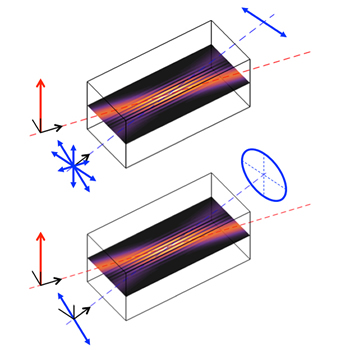Papers and Presentations - 2014
November
Controlling Laser Beam Polarization in Plasma
Since the early days of NIF implosion experiments, researchers have been taking advantage of a technique for manipulating the energy of NIF’s laser beams called cross-beam energy transfer, both to improve implosion symmetry and to avoid regions of the hohlraum most prone to energy losses due to backscatter.
Cross-beam transfer can occur in a plasma when two or more high-power lasers traveling in different directions overlap. This creates a grating, or high-power mirror, in the plasma that can be used to redirect the incoming laser light from one beam to another.
Many experiments in NIF hohlraum targets have demonstrated symmetric capsule implosion by carefully controlling the balance between different cones of laser beams through two and three-wavelength tuning of the cross-beam power transfer. Conceptual designs for a laser-plasma linear polarizer (top) and a laser-plasma wave plate with circular, or rotating, polarization (bottom). A powerful laser beam (blue) can theoretically be polarized by sending it through a plasma where it interacts with a second, more powerful beam (red). The wave-plate, or circular, polarization concept would enable laser-beam polarization smoothing even without cross-beam energy transfer. In an effort to further investigate how plasmas can be used to manipulate light, LLNL physicist Pierre Michel and colleagues recently began to investigate ways to control the polarization of these intense beams.
Conceptual designs for a laser-plasma linear polarizer (top) and a laser-plasma wave plate with circular, or rotating, polarization (bottom). A powerful laser beam (blue) can theoretically be polarized by sending it through a plasma where it interacts with a second, more powerful beam (red). The wave-plate, or circular, polarization concept would enable laser-beam polarization smoothing even without cross-beam energy transfer. In an effort to further investigate how plasmas can be used to manipulate light, LLNL physicist Pierre Michel and colleagues recently began to investigate ways to control the polarization of these intense beams.
“Laser facilities such as NIF and OMEGA (at the University of Rochester) use optical techniques called ‘polarization smoothing’ to scramble the polarizations of laser beams and mitigate laser-plasma instabilities,” Michel said. “Our new study has revealed that when multiple laser beams overlap in a plasma, the plasma can become birefringent (refract light in two different directions), which can lead to a similar polarization smoothing effect.
“This is important for large-scale laser facilities,” he said, “because it shows that under certain conditions, like the ones typically found in high energy density (HED) or inertial confinement fusion (ICF) experiments, some amount of polarization smoothing is in fact intrinsically obtained as the lasers overlap in the target. Such effects will also affect other laser-plasma interaction phenomena, such as backscatter instabilities or cross-beam energy transfer.”
As they studied the theory, the researchers realized that the plasma-manipulation technique also could be used to create novel photonics devices such as laser-plasma polarizers and wave plates. They reported their findings in the Nov. 14 issue of Physical Review Letters.
By combining a “probe” beam with a “pump” beam inside a plasma, they said, the technique of controlled optical wave mixing “can allow complete control of the polarization state of the probe beam. The probe’s polarization can be adjusted by modifying the amplitude or the phase of its electric field; this is controlled by varying the pump intensity and tuning the phase velocity of the resulting beat wave via small wavelength shifts between the lasers.”
Laser-plasma polarizers and wave plates created this way could be used to overcome the laser energy limitations of normal optical polarization devices, such as ultrafast Pockels cells (optical switches), the researchers said. “These results are relevant to a wide variety of pump-probe laser-matter interaction experiments, as well as multi-laser-beam experiments for HED science or ICF on large scale laser facilities.”
They could lead to “the development of new plasma-based photonics devices for the control of laser polarization at high intensity, with various possible applications such as dynamical polarization switching or optical beam smoothing.”
Michel said polarization control might also be useful for the new generation of compact electron accelerators that are currently in development, since they also involve laser-generated plasma. He said the research team expects to test the theory experimentally early next year.
Dustin Froula of the Laboratory of Laser Energetics at the University of Rochester told the American Physical Society’s “Physics” Website that the Livermore team is “top-notch” and well positioned to evaluate the new devices. “It’s certainly not easy,” he said, adding that, with the growing understanding of laser-plasma interactions in recent years, “we can begin to engineer their effects into our science applications.”
Lead author Michel was joined on the Physical Review Letters paper by LLNL colleagues Laurent Divol, David Turnbull, and John Moody.



